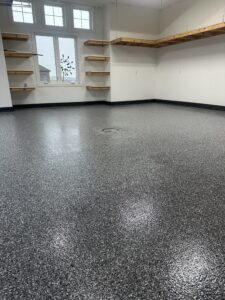Polyaspartic coatings and epoxy coatings are both popular choices for garage floors, but they come with distinct characteristics. Here are some benefits of polyaspartic over epoxy:
1. **Quick Curing Time:**
One of the most significant advantages of polyaspartic coatings is their rapid curing time. Polyaspartic can cure in a matter of hours, allowing for a faster application process and quicker return to normal use of the garage compared to epoxy, which typically takes longer to cure.
2. **Temperature Tolerance:**
Polyaspartic coatings are known for their ability to cure in a wide range of temperatures, including colder conditions. Epoxy coatings may have limitations in terms of temperature, making polyaspartic a more flexible choice, especially in regions with varying climates.
3. **UV Stability:**
Polyaspartic coatings tend to have better UV resistance compared to epoxy. This means that they are less likely to yellow or chalk when exposed to sunlight over time. This makes polyaspartic a preferable option for outdoor applications or areas with significant exposure to natural light.
4. **Flexibility and Impact Resistance:**
Polyaspartic coatings are more flexible and exhibit better impact resistance than epoxy. This flexibility can be advantageous in environments where the floor may experience slight movement, reducing the risk of cracking or chipping that may occur with more rigid epoxy coatings.
5. **Enhanced Chemical Resistance:**
While both polyaspartic and epoxy coatings offer good chemical resistance, polyaspartic coatings may excel in certain situations. They are particularly resistant to certain chemicals and solvents, making them a preferred choice for environments where exposure to harsh substances is a concern.
6. **Adhesion to Damp Surfaces:**
Polyaspartic coatings often have better adhesion properties to damp or moist surfaces compared to epoxy. This characteristic can be beneficial during the application process, especially in environments where ensuring a completely dry substrate is challenging.
7. **Low Odor during Application:**
Polyaspartic coatings typically have a lower odor during application compared to epoxy. This can be a crucial factor for homeowners who are sensitive to strong odors or for situations where ventilation is limited.
8. **Long-Term Clarity and Gloss Retention:**
Polyaspartic coatings tend to maintain their clarity and gloss over a more extended period, even in high-traffic areas. This can result in a more aesthetically pleasing and durable finish compared to epoxy, which may experience a gradual reduction in gloss over time.
It's important to note that the choice between polyaspartic and epoxy coatings depends on specific project requirements, budget considerations, and personal preferences. Each type of coating has its strengths, and the best choice may vary based on factors such as climate, desired curing time, and the specific conditions the floor will face.

